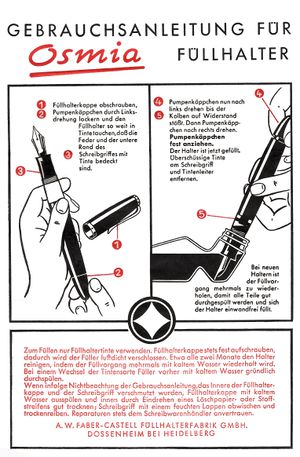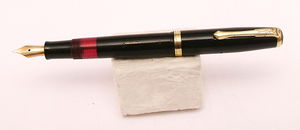Differenze tra le versioni di "Osmia/en"
| Riga 6: | Riga 6: | ||
==History== | ==History== | ||
| − | [[Osmia]] was founded in [[1919]] by ''Hermann Böhler'' under the name of ''Böhler und Cie'', in Dossenheim, near Heidelberg. Böhler, as many others of his colleagues who made a similar choice, left [[Kaweco]] to create a new company with his brother Georg, leveraging the expertise gained in this field inside [[Kaweco]] during the years in which that company acquired [[A. Morton & Co.]] to realize a production of gold nibs. | + | [[Osmia]] was founded in [[1919]] by ''Hermann Böhler'' under the name of ''Böhler und Cie'', in Dossenheim, near Heidelberg. Böhler, as many others of his colleagues who made a similar choice, left [[Kaweco]] to create a new company with his brother Georg, leveraging the expertise gained in this field inside [[Kaweco]], during the years in which that company acquired [[A. Morton & Co.]] to realize a production of gold nibs. |
| − | + | La produzione iniziale della [[Osmia]] era costituita principalmente da matite meccaniche e stilografiche in ebanite con caricamento [[safety]]. Il marchio della [[Osmia]] era costituito da un rombo collocato all'interno di un cerchio. La prima versione del marchio era costituita da una croce greca convessa, ma è stato riportato<ref>[http://www.fountainpennetwork.com/forum/index.php?s=c45f3e9adbdca24ea62226e4eabdbc10&showtopic=15065 Un messaggio di FPN] con il riassunto di una intervista a Gregor Miltner, impiegato nell'azienda dalla nascita, ed anche presidente negli ultimi anni.</ref> che data la somiglianza con il proprio marchio la [[Montblanc]] intentò causa richiedendo un risarcimento elevatissimo e la distruzione completa di tutta la produzione. La cosa avrebbe distrutto l'azienda, ma la causa si risolse con un accordo e Böhler dovette modificare il simbolo trasformando la croce in un rombo. | |
[[Image:Osmia-Instruction2.jpg|thumb|left| [[Osmia|Osmia Faber-Castell]] instruction sheet]] | [[Image:Osmia-Instruction2.jpg|thumb|left| [[Osmia|Osmia Faber-Castell]] instruction sheet]] | ||
| Riga 14: | Riga 14: | ||
The company name, [[Osmia]], derived from a special metal alloy, called ''Osmiumalloy'' for which the Böhler brothers obtained the use thanks to a patent of the Heraeus company in Hanau,<ref>[http://www.fountainpennetwork.com/forum/index.php?s=c45f3e9adbdca24ea62226e4eabdbc10&showtopic=20363 A FPN message] with more details about the topic of [[Osmia]] nibs.</ref> The ''Osmiumalloy'' was used widely for the tips of the [[Osmia]] nibs, and the alloy, though much more expensive, had a much higher quality respect to natural iridium then available in Germany (which contained many impurities that it favoured wear), and allowed the company to provide a lifetime warranty on their pens. | The company name, [[Osmia]], derived from a special metal alloy, called ''Osmiumalloy'' for which the Böhler brothers obtained the use thanks to a patent of the Heraeus company in Hanau,<ref>[http://www.fountainpennetwork.com/forum/index.php?s=c45f3e9adbdca24ea62226e4eabdbc10&showtopic=20363 A FPN message] with more details about the topic of [[Osmia]] nibs.</ref> The ''Osmiumalloy'' was used widely for the tips of the [[Osmia]] nibs, and the alloy, though much more expensive, had a much higher quality respect to natural iridium then available in Germany (which contained many impurities that it favoured wear), and allowed the company to provide a lifetime warranty on their pens. | ||
| − | [[Osmia]] | + | La [[Osmia]] ebbe un grosso successo iniziale, diventando in breve il secondo produttore di penne del paese, tanto che venne creata appositamente una fabbrica di pennini. Verso la fine degli anni '20 però le vendite avevano subito un rallentamento ed i margini erano scarsi, per cui l'azienda si ritrovò in difficoltà finanziarie. E' in questo periodo che la [[Parker]], che stava cercando di espandersi in Europa, iniziò ad interessarsi alla [[Osmia]] che acquisì (o con la quale assunse una compartecipazione, le fonti non sono chiare) nel [[1928]]. In questo periodo l'azienda produsse le [[Duofold]] per il mercato europeo, riconoscibili per la stampigliatura ''Parker - Osmia A. G. Heidelberg''. |
| − | + | Nello stesso periodo continuò la produzione a marchio [[Osmia]], con penne [[rientranti]] in ebanite rosso/nera, penne a levetta e matite meccaniche, per le quali restava anche il logo originale sul cappuccio. Intorno al [[1930]] la [[Parker]] si ritirò dato che le vendite della [[Duofold]] non avevano avuto un grande successo a causa del prezzo troppo elevato per il mercato tedesco e del pennino troppo rigido. L'attività proseguì (o venne ceduta,di nuovo le fonti non sono chiare) alla ''Osmia Gmbh'', sotto la direzione dei fratelli Böhler. Venne lanciata una nuova linea, la [[Osmia Supra]], simile alle [[Duofold]], con un caricamento a [[pulsante di fondo]] perfezionato, ed il logo in ottone smaltato sulla cima del cappuccio. | |
In [[1932]], facing financial difficulties for the return of investment to the [[Parker]], the nib factory was sold to [[Degussa]]. In [[1933]] the pen style was amended to follow the [[streamlined]] trend also used by [[Duofold]] of the same time. Were also launched other models: the [[Luxus]] line, a torpedo-shaped [[piston filler]], and the the [[Osmia Progress]], with a filling system similar to the [[Vacumatic]] one. Despite the financial troubles due to end of the cooperation with [[Parker]], [[Osmia]] got a good selling success. | In [[1932]], facing financial difficulties for the return of investment to the [[Parker]], the nib factory was sold to [[Degussa]]. In [[1933]] the pen style was amended to follow the [[streamlined]] trend also used by [[Duofold]] of the same time. Were also launched other models: the [[Luxus]] line, a torpedo-shaped [[piston filler]], and the the [[Osmia Progress]], with a filling system similar to the [[Vacumatic]] one. Despite the financial troubles due to end of the cooperation with [[Parker]], [[Osmia]] got a good selling success. | ||
| Riga 29: | Riga 29: | ||
In the late '30s, because of World War II, like all other German manufacturers the company suffered major difficulties, but despite the production was reduced for the call to arms of most of the employees, it remained active. After the war, not having the facilities suffered significant damage, production was resumed at full speed from [[1946]], proposing the same models of before, but with only with a [[piston filler]] and with the explicit endorsement (in addition to the [[Osmia]] brand and logo) of ''A. W. Faber-Castell''. | In the late '30s, because of World War II, like all other German manufacturers the company suffered major difficulties, but despite the production was reduced for the call to arms of most of the employees, it remained active. After the war, not having the facilities suffered significant damage, production was resumed at full speed from [[1946]], proposing the same models of before, but with only with a [[piston filler]] and with the explicit endorsement (in addition to the [[Osmia]] brand and logo) of ''A. W. Faber-Castell''. | ||
| − | + | Negli anni '50 la [[Osmia]] introdusse una serie di nuovi modelli, come la [[Supra 880]], in tre misure (2, 3 e 4) di colore nero con vera sul cappuccio e indicatore del livello di inchiostro, la [[Supra 666]] in quattro misure (1, 2, 3 e 4), di colori nero, grigio perla e rosso perla, con vere sul cappuccio e pennini in oro e acciaio, la [[Osmia 74D]] in plastica nera intagliata, progettata per eseguire copie carbone e la [[Osmia 52]], per il mercato studentesco. | |
Starting from [[1955]] were introduced two more streamlined models: the most prestigious, which were intended to compete with the [[Montblanc]] [[Montblanc 14x|146]] and [[Montblanc 14x|149]], were [[Osmia 44x|446]] and [[Osmia 44x|448]], with three ring and the logo engraved on the cap, bicolored gold nib and a straight clip. To these followed the mid-range models [[Osmia 88x|882]], [[Osmia 88x|883]] and [[Osmia 88x|884]], in black or green stripes, a band on the cap and a beak clip. | Starting from [[1955]] were introduced two more streamlined models: the most prestigious, which were intended to compete with the [[Montblanc]] [[Montblanc 14x|146]] and [[Montblanc 14x|149]], were [[Osmia 44x|446]] and [[Osmia 44x|448]], with three ring and the logo engraved on the cap, bicolored gold nib and a straight clip. To these followed the mid-range models [[Osmia 88x|882]], [[Osmia 88x|883]] and [[Osmia 88x|884]], in black or green stripes, a band on the cap and a beak clip. | ||
Versione delle 19:07, 25 lug 2016
Osmia was founded in 1919 by Hermann Böhler and has been for long one of the leading German fountain pens manufacturers, and it was for a short period a Parker subsidiary for european production. Since 1935 the Osmia essentially became a division of Faber-Castell, who started an acquisiton, completed in 1951.
But because the prestige of the brand, acquired by Osmia thanks to the absolute quality of his pens, the trademark was maintained for a long time after the complete acquisition by Faber-Castell. It disappeared only in the early '60s, when the crisis derived from the success of the ballpoint pen pushed Faber-Castell to produce cheaper models.
| Osmia |
|---|
| Brand pages |
| Brand advertising |
| Brand photos |
| Instructions sheet |
| Other documents |
| Patents |
History
Osmia was founded in 1919 by Hermann Böhler under the name of Böhler und Cie, in Dossenheim, near Heidelberg. Böhler, as many others of his colleagues who made a similar choice, left Kaweco to create a new company with his brother Georg, leveraging the expertise gained in this field inside Kaweco, during the years in which that company acquired A. Morton & Co. to realize a production of gold nibs.
La produzione iniziale della Osmia era costituita principalmente da matite meccaniche e stilografiche in ebanite con caricamento safety. Il marchio della Osmia era costituito da un rombo collocato all'interno di un cerchio. La prima versione del marchio era costituita da una croce greca convessa, ma è stato riportato[1] che data la somiglianza con il proprio marchio la Montblanc intentò causa richiedendo un risarcimento elevatissimo e la distruzione completa di tutta la produzione. La cosa avrebbe distrutto l'azienda, ma la causa si risolse con un accordo e Böhler dovette modificare il simbolo trasformando la croce in un rombo.

The company name, Osmia, derived from a special metal alloy, called Osmiumalloy for which the Böhler brothers obtained the use thanks to a patent of the Heraeus company in Hanau,[2] The Osmiumalloy was used widely for the tips of the Osmia nibs, and the alloy, though much more expensive, had a much higher quality respect to natural iridium then available in Germany (which contained many impurities that it favoured wear), and allowed the company to provide a lifetime warranty on their pens.
La Osmia ebbe un grosso successo iniziale, diventando in breve il secondo produttore di penne del paese, tanto che venne creata appositamente una fabbrica di pennini. Verso la fine degli anni '20 però le vendite avevano subito un rallentamento ed i margini erano scarsi, per cui l'azienda si ritrovò in difficoltà finanziarie. E' in questo periodo che la Parker, che stava cercando di espandersi in Europa, iniziò ad interessarsi alla Osmia che acquisì (o con la quale assunse una compartecipazione, le fonti non sono chiare) nel 1928. In questo periodo l'azienda produsse le Duofold per il mercato europeo, riconoscibili per la stampigliatura Parker - Osmia A. G. Heidelberg.
Nello stesso periodo continuò la produzione a marchio Osmia, con penne rientranti in ebanite rosso/nera, penne a levetta e matite meccaniche, per le quali restava anche il logo originale sul cappuccio. Intorno al 1930 la Parker si ritirò dato che le vendite della Duofold non avevano avuto un grande successo a causa del prezzo troppo elevato per il mercato tedesco e del pennino troppo rigido. L'attività proseguì (o venne ceduta,di nuovo le fonti non sono chiare) alla Osmia Gmbh, sotto la direzione dei fratelli Böhler. Venne lanciata una nuova linea, la Osmia Supra, simile alle Duofold, con un caricamento a pulsante di fondo perfezionato, ed il logo in ottone smaltato sulla cima del cappuccio.
In 1932, facing financial difficulties for the return of investment to the Parker, the nib factory was sold to Degussa. In 1933 the pen style was amended to follow the streamlined trend also used by Duofold of the same time. Were also launched other models: the Luxus line, a torpedo-shaped piston filler, and the the Osmia Progress, with a filling system similar to the Vacumatic one. Despite the financial troubles due to end of the cooperation with Parker, Osmia got a good selling success.
Since 1935 the company was gradually acquired by Faber-Castell, even if the final sale of all ownership was made only in 1951. The fountain pens took the inscription A. W. Faber-Castell Dossenheim but nevertheless the continued to bear the Osmia brand and logo, which was well known and respected, until the '60s. In 1938 Hermann Böhler resigned from Osmia to found in Dossenheim another company with its name that produced pens and automatic pencils.
Most of the production of Faber-Castell fountain pens was however done with Osmia trademark. In 1935 were introduced several models with different filling systems. Using the piston filler were: the Supra Luxus in chiseled black celluloid, produced in the 42, 44 and 46 measures, the Supra in the black or blue or silver or gold colors, with a black cross-striped transparent section produced in the 72, 74, 76, and 78 measures, the Brilliant similar to the Supra but only in black celluloid and in 62, 64, 66 measures, and the Brilliant, black, in 54, 55 and 56 measures.

Using a membrane filling system were the Supra Progress in plain colors (black, green, red, gray, blue, silver and gold) and 192, 193, 194 and 196 measures, and the Osmia Progress in the 92, 93, 94 and 96 measures. Finally using the button filler the Osmia Brilliant produced in black, gold, red and green and 232, 126, 127 and 128 measures.
In the late '30s, because of World War II, like all other German manufacturers the company suffered major difficulties, but despite the production was reduced for the call to arms of most of the employees, it remained active. After the war, not having the facilities suffered significant damage, production was resumed at full speed from 1946, proposing the same models of before, but with only with a piston filler and with the explicit endorsement (in addition to the Osmia brand and logo) of A. W. Faber-Castell.
Negli anni '50 la Osmia introdusse una serie di nuovi modelli, come la Supra 880, in tre misure (2, 3 e 4) di colore nero con vera sul cappuccio e indicatore del livello di inchiostro, la Supra 666 in quattro misure (1, 2, 3 e 4), di colori nero, grigio perla e rosso perla, con vere sul cappuccio e pennini in oro e acciaio, la Osmia 74D in plastica nera intagliata, progettata per eseguire copie carbone e la Osmia 52, per il mercato studentesco.
Starting from 1955 were introduced two more streamlined models: the most prestigious, which were intended to compete with the Montblanc 146 and 149, were 446 and 448, with three ring and the logo engraved on the cap, bicolored gold nib and a straight clip. To these followed the mid-range models 882, 883 and 884, in black or green stripes, a band on the cap and a beak clip.
In the early '60s the Osmia trademark was no longer used; a number of hooded nib plastic models were introduced, they were thinner than previous one and marked A. W. Faber-Castell, with a transparent section for ink level view. The luxury line was called 66, with body in black, red, blue or green plastic, rolled gold cap and gold nib, the mid range models were called Faber-Castell Progress and produced in three versions: the 77S in plastic with a steel nib, the 55S with silver cap, plastic body and steel nib, the 55G with gold nib. It was also produced a student model called 54VT, because the Vest Tank, with a secondary reservoir usable through a valve.
In the late '60s, as for most of the other fountain pens producers, having also completely erased a prestigious brand that enjoyed a wide popularity, sales had an irreversible decline, holding only partially for the students pens. In 1975, during a corporation restructuration, Faber-Castell completely eliminated the entire field of fountain pens production, resuming today, with the return of interest for this popular writing tool.
In the early '60s Faber-Castell ceased to use the Osmia trademark, starting to a production of cheap models for the scholastic market marked only by its brand name, with a drastic reduction in sales, accentuated even more by having removed from the market a prestigious brand.
Chronology
| Year | Event |
|---|---|
| 1919 | the company is founded by Hermann Böhler in Dossenheim as Böhler und Cie |
| 1928 | Parker acquire Osmia for the european production |
| 1930 | Parker retires from Osmia and the Osmia GmbH is founded |
| 1932 | Degussa acquire the Osmia nib production unit |
| 1935 | the company introduces the Progress |
| 1935 | the company introduces the Osmia Supra |
| 1935 | the company introduces the Supra Progress |
| 1935 | the company introduces the Brilliant |
| 1935 | the company introduces the Osmia Supra Luxus |
| 1935 | the company introduces the Osmia Brilliant |
| 1935 | Faber-Castellbegins Osmia acquisition |
| 1938 | Hermann Böhler leaves Osmia to found Böhler |
| 1946 | the company restarts production |
| 1951 | Faber-Castell complete Osmia acquisition |
External references
Notes
- ↑ Un messaggio di FPN con il riassunto di una intervista a Gregor Miltner, impiegato nell'azienda dalla nascita, ed anche presidente negli ultimi anni.
- ↑ A FPN message with more details about the topic of Osmia nibs.
